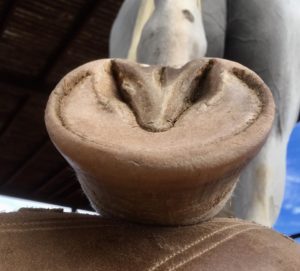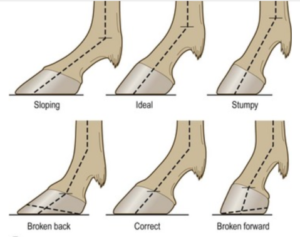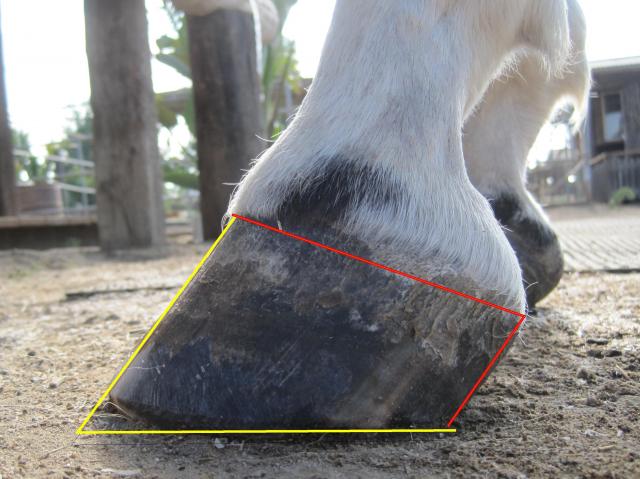Wouldn’t it make life so much easier if we had a hard-and-fast, always-and-never guide for trimming our horses’ hooves? Unfortunately the hoof can’t be simplified like that. The hoof is an amazing feat of natural engineering that offers an infinite combination of variations within “normal” ranges. To make it even more complicated, our horses can add long-existing pathologies, traumatic injury, compensation for conformational quirks, and other anomalies that change how we care for the hoof.
Likely the one aspect of trimming with the most exceptions to any rule is heel height. Ideal palmar angle is considered to be anywhere from zero to ten degrees. How do we decide what’s right for each horse?

In many cases, we won’t have radiographs to guide us. The standard guidance in the absence of radiographs is to use the live sole plane in the heel triangle as a guide, and trim the heels to about 1/8″ inch above the sole plane. This is an excellent parameter, and probably the best standard out there, but it’s still not that simple. There are several factors that need to be considered to determine appropriate heel height.
Dorsal & Hairline Angles

It is generally agreed upon that between 50 and 55 degrees is the average healthy dorsal angle for front feet. Some barefoot protocols prescribe a much lower angle. You’ll have to decide for yourself and your specific horse which angle is best. Keep in mind, though, that a certain angle should never be achieved by thinning the hoof wall. Also, make sure your horse’s hoof has no dorsal flare that would make it appear to have a much lower dorsal angle.
There are also different opinions as to what constitutes a healthy hairline angle. Anywhere between 20 and 30 degrees is generally considered ideal.
Live Sole Plane

The strategy of adding 1/8 of an inch to the live sole plane is going to work well for many horses. But don’t make the mistake of trimming to live sole at the heel, and then trimming to callused sole in the front of the foot. If you have a half inch of callus in the front of the foot, but exfoliate down to waxy sole at the heel, you could easily imbalance the foot.
Trimming to 1/8 of an inch above the live sole plane probably won’t work for horses with unhealthy frogs or an underdeveloped or weak digital cushion.
Collateral Groove Depth
Collateral groove depth at the heel can also be a great way to gauge heel height. 5/8 of an inch to one inch works well in many cases. But that 3/8 if an inch difference can make or break a horse’s comfort, so it’s important to weigh all of the other factors.
Comfort

This one sounds obvious, but it can present a bit of a conundrum if you’re working to change a problem foot. Sure, if you leave a lot of heel, the horse might be more comfortable for now, but in most cases, that is ultimately not a healthy trim. The key, then, is to do everything you possibly can to make the correct trim comfortable for the horse.
Ultimately, if you try one approach, and it leaves the horse very uncomfortable and walking on its toes, you’ve taken too much too soon. In their Hoof Rehabilitation Protocol, Dr. Debra Taylor and Pete Ramey recommend no more than a “maximum change of 10 millimeters [relative to the toe] to heel height in one session.” Re-evaluate and try something different. We hope this arms you with a little more information upon which to base your heel height decision.






Is it really that difficult to trim the horse to its ideal hoof. I say NO! As long as one respects the sole as the ultimate guideline to what the horse needs. Trimers should not make things more difficult as they are. Horses have been living on this planet for millions of years. They did not messure angles. The ground trimed there hoofs and that’s what we need to do. Be as smart as the ground. Trim what is standing above the sole give it a nice bevel to the white line and leave the heels alone. Maybe the hoof does not look as symetrical or pretty as we want it but it sure will start to balance itself and fit the horses bones and ligaments above. A keyfactor on keeping a horse healthy. And a healthy horse is a happy horse and that will make for a happy owner as well. I trim successfully by this rules for many years now and it does not matter, if the horses have a pathology. The trim rules remain the same.
Methode used: HGM by Maureen Tierney
Hi, a great article. Do you have any illustrations to demonstrate what the 1/8″ heel height above the live sole plain looks like as I am having difficulties recognizing what it should look like.
Many thanks
Sue
Thank you for bringing that up. I added another picture to the Live Sole Plane section of this post that shows how you want the hoof wall to be trimmed 1/8 of an inch or so (generally speaking) above the sole.
Dr Savoldi did an excellent article on “The Universal Sole Plane” showing a very clear dissection of a foot I commonly see (it’s actually long toes and high heeled). The dissection clearly shows the effects of excess heel height and the resulting dorsal wall/sole pressure from the torque…..leading to P3 modification. Really excellent in my opinion
Thank you for sharing that article!
Comments are closed.